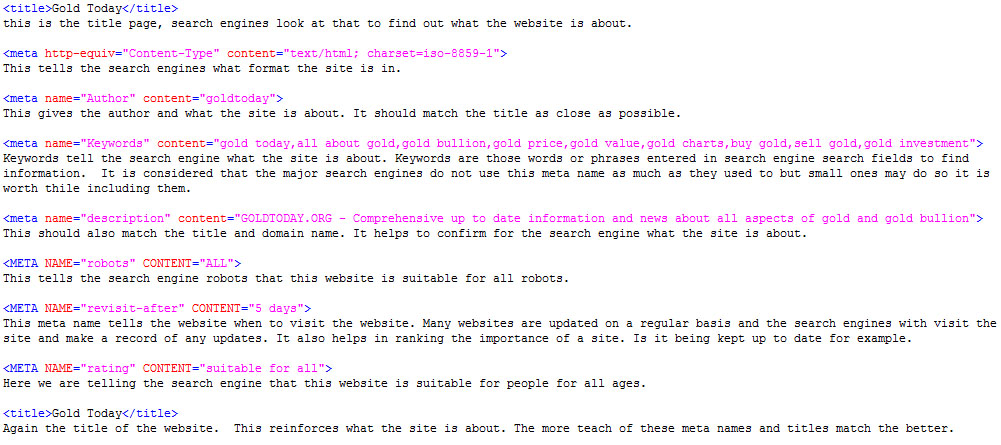Search Engine Optimization (SEO)
If you are going to have a website and you want people to come to your website it is a good idea to have some understanding of Search Engine Optimization or SEO. SEO is the process, or science if you will, of setting up a website in such a way that one can improve the traffic volume and quality to the website from search engines. This is called ‘organic’ or unpaid for traffic as distinct to Search Engine Marketing (SEM) where one gains traffic by the simple expedient of paying for ads to entice people to visit the site.
SEO is the action of designing websites that are higher in ranking or closer to the top of the first page shown by a search engine when a phrase or key words are entered in the search field. The closer to the top of the first page offered as a result of a search, the more traffic one is likely to get.
For example, if one had a website called www.wigglywoos.com, then theoretically anyone that typed in wiggly woos in the search field would net that website as the first one on the page.
Of course it is a bit more complex than that. There many be hundreds or even thousands of websites concerning wiggly woos so how does a search engine determine which is the best website for that query? There are many factors or criteria which a search engine takes into account when selecting which it considers the best site.
In broad terms the search engines, and by search engines we are talking about Google, Bing, Yahoo and AOL for example, will pick out to display websites or pages they consider the most important or relevant to the search criteria the individual has entered in the search field. With our example above, there might be 50,000 websites that have the words wiggly woos in the title or are evident by the content they are about or concerning wiggly woos. The search engine has to decide which of those is going to be most relevant to the search term entered in the search field. You can try this yourself. If you enter wiggle woos in the search field of Google, you will find there are about 32,900 pages for wiggle woos with 10 entries on each page (for the purposes of SEO we can ignore subsequent pages. Rarely does anyone look beyond the first page) and just being listed with a search engine is not enough to get you seen. It takes a little more than that!
SEO is about getting your page ranked as the first or at least in the first 5 or six entries on the first page in a search engine such as Google or Bing to supply over 95 percent of the search results.
Why?
Well how many people are going to scroll down to the bottom of the search engine page, or look at page two or three or even four. Not many. How many people are going to look at page 100 or page 32,459? Even less. In fact it would be a safe bet to say zero!
So to be seen and to get the most traffic to ones site is what it is all about. That is the purpose of SEO.
So how do you find out how to get yourself on page one of a search engine? It is possible to ‘infer’ various criteria and many people spend a lot of time in intense and excited discussion on various websites, forums and discussion lists. There are companies that also put out software and the ‘answer’ to the secret of how search engines determine the best site, for a price. Virtually all of these can be ignored and you can save your money. No know knows the exact criteria search engines use to rank or grade websites or web pages. That is a closely guarded secret all the search engines clutch to their bosom.
However there are some basics which do make a difference to how well or important to the world your website is considered and knowing these basics and putting them into practice can make a big difference to how well known your website becomes. Better still, it does not cost anything to know these basics as they are outlined here.
So what are the basics one needs to know to set up a website that will be noticed by the search engines and given it’s appropriate relevance? Whole treaties have been written on this subject and one can spend thousands of dollars on information about the ‘secrets of SEO’, but if one keeps in mind the following, one can improve one’s ranking very well without spending a brass razzoo.
There are five main points to consider when setting up or even upgrading a website.
1. Proper code on the site that the search engines like.
2. Links to the website from other sites
3. Content
4. Content
5. Content
There are other factors that can affect ones rankings and no one, apart from the search engine engineers, knows fully what all of these are so this is only a guide and not a guarantee that your site will rank top most in any or all search engines.
Proper Code
Proper Code for the website. This means that it should have a title that explains the website. The code in the beginning of the site (which is not displayed on the webpage but is available to search engines) should be consistent with the purpose of the website and what is contained on the website. Calling a site, “Pyjamas for all” and the site being concerned with “Gardenias, how to grow them” would be inconsistent. There is specific code which all websites have and which can be found by going to any website and clicking the right button on the mouse and selecting ‘source code’.
There you will see a series of ‘Meta’ elements. These pieces of code are there for the benefit of search engines and help it to grade it or assign an importance to the site. They are used to provide structured data about a web page. Such elements must be placed as tags in the head or top section of a web site. Meta elements can be used to specify page description, keywords and any other data not provided through other parts of the webpage.
Here is an example:

Each of these ‘meta tags’ give information about the site to the search engines including the title, what the site is about, how it is presented, who can visit it and how often the search engine should visit the site. And who the site is suitable for. These are just a few of the possible meta tags you can have and your web site developer will be familiar with them.
As you can see, in this example, the overall theme of the site is Gold Today (A dummy site used for testing) and all words and meta tags are relevant to the subject. You can check this on any website and right clicking your mouse on the page, selecting ‘View page source’ if you are in Firefox or ‘View Source’ if in MSIE. You will then see the code that has been used to help the search engines find the site when people put in a query for contents on that site.
There is other code that can help which your webmaster should be aware of. Using designated headers of various importance for titles, sections and paragraphs is important as it helps the search engines to see the various importance’s of each section of text. Having images with text accompanying that describes the images is also ‘search engine user friendly’.
Of course finding and employing a top quality SEO specialist and webmaster is vital and, although may be more expensive that the chappie next door, will pay off in dividends later.
Links to the Website
Links to the website from other websites is important. It is generally accepted that high quality links will improve your ranking in relation to similar sites. The search engines decide the importance of course but it could be considered safe to say that websites that are already high ranking and in demand would be considered better than sites just started with virtually no visits at all.
From the search engines point of view it is important that people consider the search engine reliable and present to the person seeking information, the right and relevant information, otherwise that person may leave and go to a different search engine. Search engines then, go to great efforts to ensure that the information they present is as relevant to the person browsing at possible. This means that if other high ranking sites consider a website important enough to add links to it, then the search engine will have some agreement with that.
Some people work to circumvent this by using what are called link farms. A link farm is a group of web sites that all link to every other site in the group. Some link farms are created by hand, but most are created through automated programs and services. A link farm is frowned upon by search engines who will consider it a method of spamming the index of a search engine and search engines, when they find it, are liable to remove the offending sites and relegate that or those sites to the bottom of the pile. So it does not pay to use link farms. One can encourage major sites to link to ones site by showing the relevance and importance of the site and how it contributes to the site being linked from. This is a better way to get high value sites linking to your own.
Sometimes people pay to have people link to the website. This can be done through marketing and will be covered in a forthcoming article on Search Engine Marketing (SEM).
Content
Arguably the most important of the three basics is content. Hence repeating this three times. Content is the information on the website. The meat in the pie. The guts if you will. The entire reason why anyone would want to visit your website in the first place. So it is vital that the content of your website is something people will want to read.
The more original and informative the content the more the search engines will like it. Simply copying or even rewriting information other existing websites will not help you. Search engines look for this and as these are time date stamped content on an earlier site will take precedence over a later one. There are possible exceptions. A high ranking site, say 8 out of 10 will probably take precedence over a lower ranking site of say 4 out of ten even though the 4 out of ten site may have had the content first. The higher ranking site may be ranked high for other reasons or other content on your site so that can have a bearing on it also. Generally speaking though, if one copies from another site, in all likelihood one’s site will then be relegated to a second best site. So the more original and different your content is the better. Content should be meaty. Have substance. Being well written and easy for people to read as well as being interesting makes a big difference. Content should also be relevant to the website title and code. A website about gold is not likely to draw much attention with text about building box girder bridges. But text concerning gold will be considered relevant to the title and code on the site.
Of course there are more detailed factors that can be used to improve your rankings and end up on top with thousands of hits. Use of social networks such as Facebook, Twitter and the like can all help. The use of blogs and forums to promote ones site and get some enthusiasm going for it are all ways that, over the recent years, have been used and are more and more used to bring websites to the attention of prospective lookers.
The above has really only touched upon SEO but by the diligent use of the basics shown above, one can quite likely achieve a respectable ranking with the search engines.


